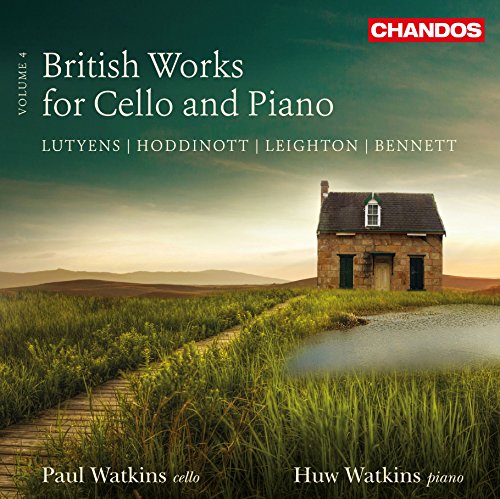British Works for Cello and Piano
View record and artist detailsRecord and Artist Details
Composer or Director: Richard Rodney Bennett, Alun Hoddinott, Kenneth Leighton, (Agnes) Elisabeth Lutyens
Genre:
Chamber
Label: Chandos
Magazine Review Date: 08/2015
Media Format: CD or Download
Media Runtime: 67
Mastering:
DDD
Catalogue Number: CHAN10862

Tracks:
| Composition | Artist Credit |
|---|---|
| Partita |
Kenneth Leighton, Composer
Huw Watkins, Piano Kenneth Leighton, Composer Paul Watkins, Cello |
| Constants |
(Agnes) Elisabeth Lutyens, Composer
(Agnes) Elisabeth Lutyens, Composer Huw Watkins, Piano Paul Watkins, Cello |
| Sonata for Cello and Piano |
Alun Hoddinott, Composer
Alun Hoddinott, Composer Huw Watkins, Piano Paul Watkins, Cello |
Author: Jeremy Dibble
This is evident in the earliest work featured here – Kenneth Leighton’s Partita (1959) – which begins with a singing, searingly haunting Elegy, a rhythmically dynamic Scherzo (typical of Leighton’s compelling ‘mechanistic’ moto perpetuo style) and, in a microcosm of contrasting movements, a Theme and Variations, effectively a suite of character pieces. Lutyens’s Constants (1976), more overtly expressionist in temperament, derives its title from a series of restricted harmonic and melodic intervals which feature throughout the three movements, though, even within this more challenging avant-garde dialogue between the two players, the cantabile properties of the cello ring through in the ‘Lament’ and ‘Canticle’.
Composed a year later, Alun Hoddinott’s Second Sonata begins in restive mood and is striking for its economic contrapuntal textures (often in no more than two parts), especially in the central, meditative slow movement. Richard Rodney Bennett’s Sonata of 1991, with its air of post-serial romanticism (and not without a whiff of Alban Berg), is a powerful work, full of structural invention on several architectural levels, though, of the four movements, I find the concluding miniature set of variations the most engaging for its clarity and imaginative design.
Discover the world's largest classical music catalogue with Presto Music.

Gramophone Digital Club
- Digital Edition
- Digital Archive
- Reviews Database
- Full website access
From £8.75 / month
Subscribe
Gramophone Full Club
- Print Edition
- Digital Edition
- Digital Archive
- Reviews Database
- Full website access
From £11.00 / month
Subscribe
If you are a library, university or other organisation that would be interested in an institutional subscription to Gramophone please click here for further information.




